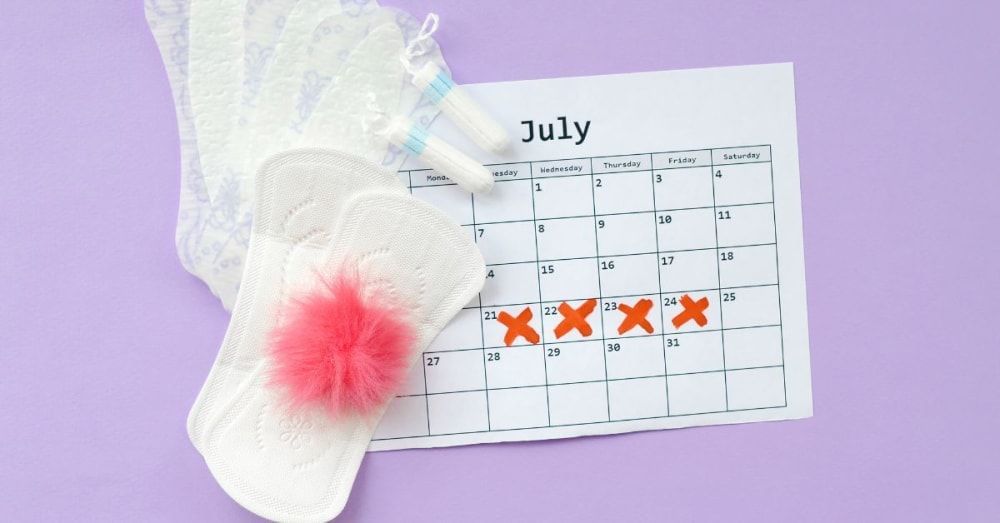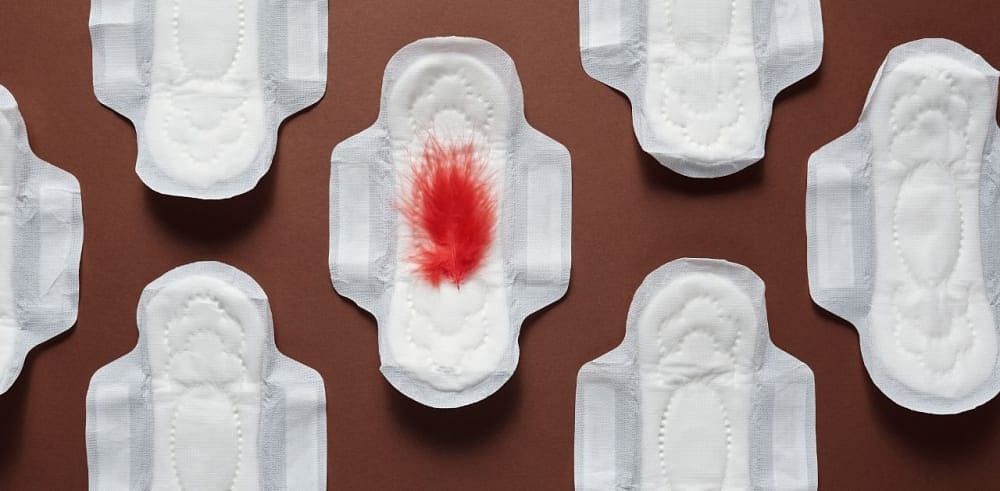Hormonal fluctuations are responsible for the onset of menstruation.
Many factors can disrupt this balance, resulting in missed periods and spotting instead of periods. Spitting refers to lighter bleeding than usual. It doesn't require much protection from a pad or tampon most of the time.
Spotting may be due to many factors and may even be normal, such as pregnancy or your age. Another cause could indicate that your doctor needs to treat an underlying condition.
This section will review the causes of these conditions and when you need to consult a doctor.

What is Spotting?
When women experience a small amount of bloodshed during the menstrual cycle, it is known as spotting. This bloodshed isn’t enough to be considered a period that typically involves menstrual bloodshed over 5-6 days. While spotting may indicate the start of a period, it may occur throughout the cycle. Moreover, spotting can also signal the start of pregnancy or be a sign of stress.
What Counts As Spotting?
Spotting instead of a period can be defined as light vaginal bleeding outside regular periods. It usually involves small amounts of blood and requires no medical intervention. Spotting can occur a week before the period, during ovulation, or after sex. However, a few spotting cases might be severe and require the consultation of doctors.
What Causes Spotting?
Did you know that around 14-25% of females of reproductive age have non-uniform periods? Spotting is exceedingly common and not a cause of concern in most cases. That said, you might need to see your doctor in severe cases. But what causes spotting instead of period? Below are some probable causes of spotting:
1. Pregnancy
Spotting at the time of a period may be caused by implantation in early pregnancy. The spotting occurs due to the fertilised egg that burrows further into the uterine lining after implantation.
Some of the other early pregnancy signs include vomiting, fatigue, and nausea. If you suspect that you may be pregnant, then consider taking a pregnancy test first thing.
2. Birth Control Pills
Women who take birth control pills might have spotting, especially in the first few months of use. That is because it may take time for such pills to regulate the menstrual cycle because the body needs to adjust to the new hormone levels. For instance, if an individual is taking progestin-only pills, then they might experience spotting.

3. Stress
Physical or mental stress can affect the menstrual regulatory pathways and alter the release of hormones. The result of this can be spotting. If the tension becomes tedious to manage, consult a doctor right away.
4. Weight
Having a super low body weight can affect your hormones. When these hormones are impacted, ovulation may stop. The result can be a condition called amenorrhoea. It happens when an individual misses more than one or two menstrual periods.
Primary amenorrhea may be a sign of malfunctioning or underdeveloped ovaries. In such a condition, an individual can experience irregular bleeding or spotting.
5. Menopause
Spotting and other menstrual irregularities may occur several years before spotting instead of period menopause. Post the first symptoms, a women’s body may take four years to transition to menopause. If you have entered menopause and witness any spotting or bleeding, you must consult a doctor immediately.
6. PCOS
Irregular periods and spotting can be a symptom of PCOS or Polycystic ovary syndrome. Androgens are hormones that can interrupt ovulation and cause PCOS spotting instead of period. When this happens, an individual may experience spotting instead of a period.

7. Thyroid Problems
As per a study, 1 in 8 women may develop a thyroid condition at some point in their life. One of the chief symptoms of the thyroid is irregular menstrual cycles. When thyroid levels are too low or high, periods may become irregular, and one may experience spotting. That is because the thyroid gland is connected with your ovaries and plays a vital role in your reproductive health.
8. Age
Young girls just starting their periods may have irregular periods or spotting as their bodies adjust to menstruation. It usually happens between the ages of 11 and 15. However, with time, the blood flow regulates and becomes more predictable.
9. Cancer
Unusual bleeding or spotting can also be symptoms of cervical cancer. As per the American Cancer Society, 90% of women with endometrial cancer tend to bleed between periods. Plus, they experience bleeding even after menopause.

How Do Doctors Diagnose The Cause Of Spotting?
Spotting instead of a period can be due to several causes. The first step doctors take to diagnose the cause of spotting is to ask questions regarding the patient’s menstrual history, type of bleeding experienced during their period, and the length of their period. Following this, the doctor might recommend a set of physical exams that will help diagnose the cause of spotting properly. These exams generally include the following:
1. Blood test
Several blood tests, including a blood clotting profile, can be performed to detect spotting instead of period.
2. Hysteroscopy
This test involves the insertion of a narrow lighted tube into the uterus to determine the presence of polyps, fibroids, or any other abnormalities.
3. Ultrasound
A transvaginal ultrasound or an ultrasound of the uterus can be helpful in the detection of spotting instead of period.
4. CT scan and MRI scan
Both these scans can help better visualise fibroids, polyps, or abnormalities that can give rise to spotting instead of period.

5. Endometrial Biopsy
This test removes and tests a small sample of the tissue from the endometrium to diagnose the reason for spotting.
Patients are required to visit the doctor with their test results to understand the cause of their spotting instead of period.
Treatments For Spotting
The treatment for spotting depends upon the underlying cause. Several possible treatments of spotting based on their underlying cause are given below.
- Spotting instead of period caused due to an infection can be treated by antibiotic therapy.
- For women with PCOS who want to become pregnant, it can be treated using fertility-enhancing drugs as well as assisted reproductive technologies.
- Sometimes birth control pills or hormonal therapy can be helpful.
- Few patients require surgery to remove cervical polyps or uterine fibroids that might cause spotting instead of period.
Spotting Vs. Period
How can you tell if you’re having a standard period or if you’re spotting? There are a few characteristics on which you can differentiate. Let’s find out what these characteristics are.
Menstrual Cycle Phases
The menstrual cycle comprises different phases, with each phase having a different length. The overall length of the menstrual cycle varies from one person to another. The menstrual cycle is divided into four main phases, as mentioned below.
1. Menstruation
This phase deals with eliminating the thickened lining of the uterus from the body. The menstrual fluid generally comprises blood, mucus, and cells from the uterus lining. The average length of this phase can be three days to a week.

2. Follicular phase
This phase starts on the first day of menstruation and ends with ovulation. The secretion of the follicle-stimulating hormone (FSH) is stimulated during this phase which further stimulates the ovary to produce 5 to 20 follicles. Only one of these follicles matures into an egg while the others die. The growth of the follicles also stimulates the uterus to prepare for a possible pregnancy.
3. Ovulation
During this phase, a mature egg is released from the ovary. This phase usually occurs two weeks before the start of menstruation. Ovulation is generally triggered by releasing the luteinising hormone (LSH) from the pituitary gland. The released egg is then propelled towards the uterus through the fallopian tube. The lifespan of an egg is typically 24 hours; unless it meets a sperm within this time, it dies.
4. Luteal phase
After the egg is released from the follicle, the ruptured follicle remains on the surface of the ovary. This ruptured follicle turns into the corpus luteum within the next two weeks. The corpus luteum releases progesterone and small amounts of oestrogen that helps maintain the uterus's thickened lining.
In case the egg is fertilised, the corpus luteum produces the human chorionic gonadotropin (hCG) hormone and maintains the thickened uterine lining. In case the egg is not fertilised, the corpus luteum withers causing a decrease in hormone levels. This, in turn, causes the shedding of the uterine wall and the repetition of the cycle.
What is The Source of The Bleeding?
The body releases tissues and blood from the uterine lining during menstruation. After that, this blood and tissue leave the uterus through the cervix through the vaginal opening.
However, the source of bleeding can vary in the case of spotting. For instance, if spotting is a symptom of cervical cancer, then the blood comes not from the uterine wall but the cervix.

What Are The Risk Factors For Spotting?
A few of the factors that might lead to spotting are:
- Approaching menopause- Spotting instead of period during menopause is a common occurence. Women approaching menopause are more susceptible to spotting due to hormonal changes.
- Pregnancy- Spotting can occur during pregnancy for several women due to implantation bleeding.
- Intake of new birth control pills or having a new intrauterine device- Birth control pills can impact the hormonal balance and lead to spots.
- Contraction of STDs or pelvic inflammatory diseases- Sometimes, spotting can occur due to inflammatory diseases and infections.
- Due to polycystic ovarian syndrome (PCOS)- PCOS spotting instead of period is quite common in women.
- Due to fibroid tumours of the uterus or cervical polyps- The presence of either tumours or polyps can quite often lead to spotting instead of period.
When to See a Doctor
One month of spotting instead of a period might not indicate any concern. If you miss your period because you're approaching menopause, or if you're very stressed one month, then you may resume your regular flow the following month without any treatment.
Other symptoms that you might experience may suggest you consult your doctor if you have a spot caused by a medical condition, such as PCOS, thyroid problems, or STIs. Pregnant women should be checked as well. You should seek treatment if you are experiencing other symptoms and spotting.
Consult your doctor if your spotting is accompanied by:
- fever or chills
- foul-smelling discharge
- pain
- other signs of infection
Summing Up on Spotting Instead of Period
It is common to experience spotting in place of your period from time to time. Many situations can disrupt the body's hormonal balance and lead to a disrupted cycle.
If you are experiencing other symptoms such as chills or fever while spotting, it's better to consult a doctor.
FAQs
1) Is It Normal to Spot and Not Have a Period?
Women often experience spotting in between periods. However, spotting frequently may signal a medical problem that needs to be addressed.
2) Can I Consider Spotting as a Period?
No, spotting and period are two very different things. In spots, blood flow is lighter and doesn't last for more than two days. It cannot be substituted for a period that lasts for 4-7 days and has a regular cycle of 21 to 35 days.
3) When Should I Be Concerned About Spotting?
It's common for spotting to occur instead of your period from time to time. You should seek treatment if you are spotting from a medical issue, such as PCOS, thyroid problems, or STIs, or if you are pregnant.
4) How Long After Spotting Should I Take a Pregnancy Test?
Pregnancy tests can be taken right after spotting since it generally occurs around the time of the expected period. Certain pregnancy tests can detect hCG hormone levels in the urine 6 days before the period. However, taking a pregnancy test too soon can also give a false negative test. In case of negative tests, people can wait for another 3 days and retake the test to be sure if they are pregnant or not.
5) Can You Be Spotting and Have a Negative Pregnancy Test?
Yes, it is possible to get a negative pregnancy test while spotting. This is because the hCG levels are not high enough to trigger a positive result. The home pregnancy kit can only detect hCG levels greater than 20 mUI/ML. Therefore taking a pregnancy test too soon can lead to a false-negative test. People can take the test after a few days of spotting instead of period since it will give the body time to produce detectable hCG levels. Besides, spotting can have various other reasons apart from pregnancy, such as menopause, IUDs or birth control pills, PCOS, etc.











